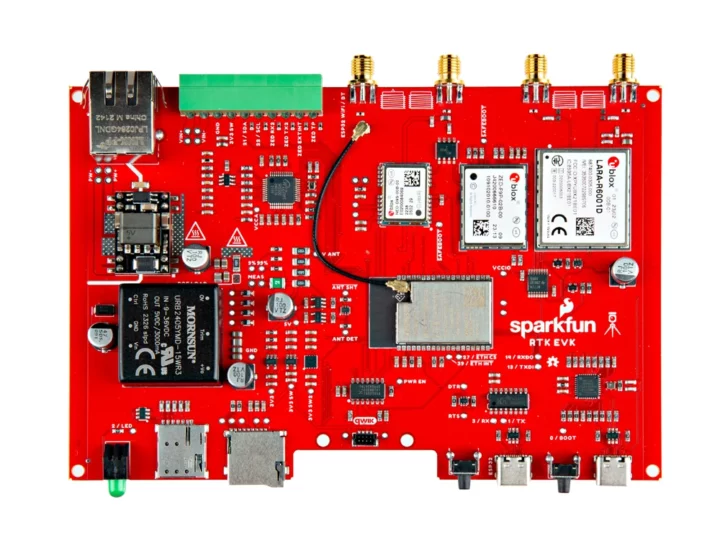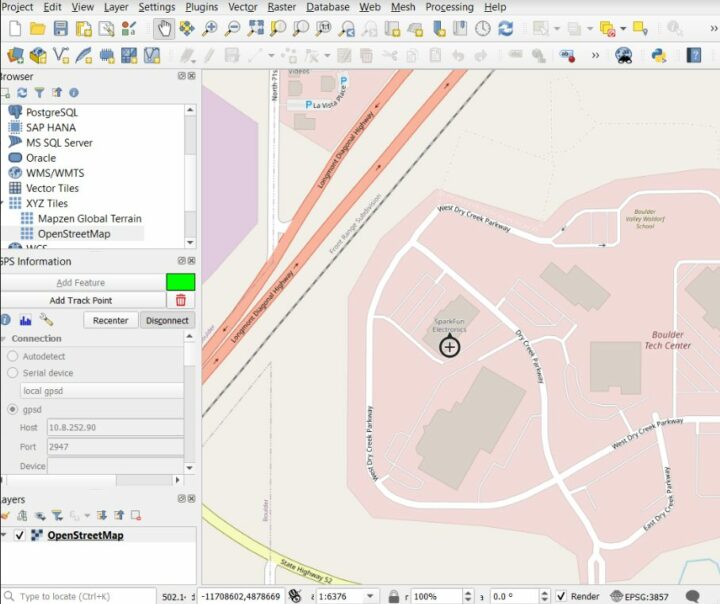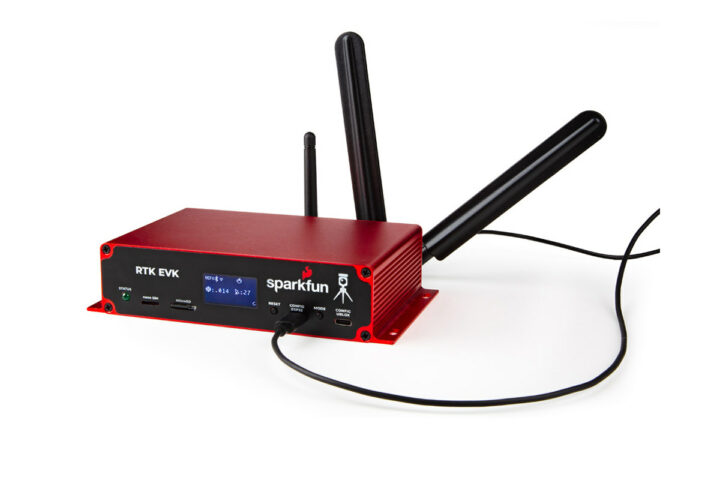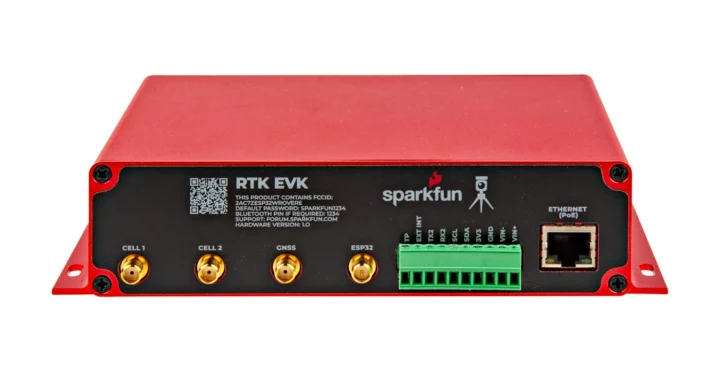SparkFun RTK EVK is a fully-enclosed GNSS platform designed for fixed or mobile high-precision positioning and navigation applications with centimeter accuracy thanks to RTK (real-time kinematic) technology implemented with modules from u-blox.
About two months ago, Sparkfun introduced the RTK Torch waterproof GNSS surveyor with Unicore UM980 GNSS module with RTK support, ESP32 for WiFi/Bluetooth, and an STM32WLE5C LoRa SoC. The SparkFun RTK EVK (evaluation kit) may drop LoRa connectivity, but it’s a more versatile platform with WiFi, Bluetooth, Ethernet, and LTE Cat 1 cellular connectivity, besides support for L1 + L2 RTK GNSS with L-Band correction.
Sparkfun RTK EVK specifications:
- GNSS Receiver – u-blox ZED-F9P
- Concurrent reception of GPS, GLONASS, Galileo, and BeiDou
- Receives both L1C/A and L2C bands
- 184-channel u-blox F9 engine
- Time to First Fix: 25s (cold), 2s (hot)
- Max Navigation Rate: 20Hz / 25Hz depending on mode
- Horizontal Position Accuracy: 2.5m without RTK; 0.010m with RTK
- Max Altitude: 50km (31 miles)
- Max Velocity: 500m/s (1118mph)
- GNSS antenna – SMA with antenna short and disconnect detection + 5V power for an active antenna
- Correction Data Receiver – u-blox NEO-D9SL
- Band data receiver compliance: SESTB28A
- Frequency range: 1525 to 1559MHz
- Sensitivity: -133dBm
- Time to First Frame: <10s
- Receives PMP messages from Inmarsat Geosynchronous Satellites
- LTE Cat 1 Cellular Module – LARA-R6001D
- Region: Global
- LTE FDD Bands: 1, 2, 3, 4, 5, 7, 8, 12, 13, 18, 19, 20, 26, & 28
- Certifications and approvals – PTCRB, GCF, FCC, ISED, RED, UKCA, NCC, RCM, Giteki, Anatel, KC, AT&T, Verizon, T-Mobile, Deutsche Telekom, Telefonica, NTT DoCoMo, SBM, KDDI, Telstra
- Connected to Nano SIM Card Slot and 2x SMA antenna connectors on RTK EVK board
- Note: Although the LARA module supports GSM/GPRS, the RTK EVK does not due to the high current required.
- ESP32-WROVER module
- Provides WiFi 4 connectivity for the RTK EVK
- Memory – 8MB PSRAM
- Storage – 16MB Flash
- Reverse Polarity (RP) SMA WiFi / BT antenna connection
- 10/100M Ethernet RJ45 port via WIZnet W5500 SPI to Ethernet chip
- Storage – MicroSD socket
- Display – 1.3-inch OLED with 128×64 pixels resolution
- USB
- 1x USB-C port (UART via CH340) connected to ESP32 module
- 1x USB-C port connected to an u-blox module (I suppose the ZED-F9P)
- I/O Connections through 3.5mm screw terminals
- Fully isolated external DC power input (9V – 36V)
- ZED-F9P GNNS module
- UART2 – TX, RX (3.3V)
- EXT-INT input (3.3V)
- Timing pulse output (3.3V)
- I2C (3.3V)
- Power
- 5V DC via u-blox USB-C connector
- 5V DC via ESP32 USB-C connector
- 36V – 57V DC via Power-over-Ethernet RJ45 port
- 9V – 36V DC via external DC power (screw terminals; fully isolated)
- Dimensions – 180.60 x 101.8 x 41.00mm (Custom extruded aluminum case with machined end panels)
- Weight – 405 grams without antennas
- Ingress Protection rating – IP42 (A different weatherproof enclosure is required for outdoor use)
Just like the RTK Torch, the RTK EVK comes pre-loaded with the open-source RTK Everywhere Arduino firmware. The firmware enables the user to configure the EVK as an RTK Base and push corrections to an NTRIP Caster over WiFi or Ethernet, or configure the EVK as an RTK Rover and use corrections delivered over WiFi, Bluetooth, or Ethernet.
While the hardware supports 4G LTE. we’re told the firmware doesn’t support the LARA-R6 cellular module just yet. As a workaround, Sparkfund has written extra code examples to stream MQTT correction data from a u-blox PointPerfect Localized Distribution topic via the LARA-R6 cellular chip. Only the data around the location is downloaded to minimize cellular data usage and associated costs.

The setup is supposed to be very easy through a feature called “Zero-Touch RTK”. The user registers the device online, connects it to Ethernet or WiFi (hotspot) or other WiFi network, enables PointPerfect, and the gateway will begin getting corrections without any further setup. Not that PointPerfect’s correction data is available in the US, EU, and various parts of Australia, Canada, Brazil, and Korea, but it does not work globally at this time, in which case you can use NTRIP instead…
The design appears to be open-source with Eagle hardware design files, Arduino sketches (including the MQTT one mentioned above), and documentation available on GitHub. The RTK EVK works with with several Android, iOS, or PC GIS apps/programs such as SW Maps (recommended, but closed-source), or the open-source Vespucci, QGIS (Windows/Linux/Mac), and QField. You’ll find out how to use those in the product manual for RTK Everywhere-compatible devices.

RTK hardware is usually pricey, even so-called “low-cost GNSS RTK solutions“, and the SparkFun RTK EVK is no exception with the evaluation kit going for $1,199.95 on the SparkFun store. You may also have to pay for “PointPerfect L-Band+IP” covering both L-Band corrections from the built-in NEO-D9S and localized corrections delivered by IP after the one-month free subscription expires. If the device is operated in a location out of range of the PointPerfect, you may either use a local RTK base station or get the data over NTRIP.

Jean-Luc started CNX Software in 2010 as a part-time endeavor, before quitting his job as a software engineering manager, and starting to write daily news, and reviews full time later in 2011.
Support CNX Software! Donate via cryptocurrencies, become a Patron on Patreon, or purchase goods on Amazon or Aliexpress






